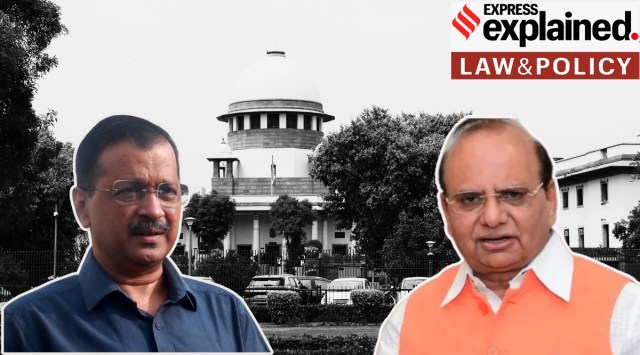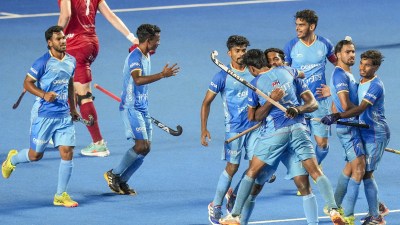
What was the issue before the Court?
In 2015, a Union Home Ministry notification said that the Lieutenant Governor of Delhi shall exercise control over “services”. The Delhi government challenged this before the Delhi High Court, which in 2017 upheld the notification. On appeal, a two-judge Bench of the Supreme Court referred the issue to a larger constitution Bench.
In 2018, a five-judge Constitution Bench, headed by then CJI Dipak Misra, in a unanimous verdict laid down the law that governs the relationship between Delhi and the Centre. The ruling was in favour of the Delhi government.
While the Constitution bench decided the larger questions, the specific issues were to be decided by a two-judge Bench. In 2019, two judges, (who were also part of the larger 5-judge Bench in 2018), Justices Ashok Bhushan and AK Sikri, delivered a split verdict on the specific issue of “services.” The split verdict then went to a three-judge Bench and eventually a five-judge Constitution Bench, which has now delivered its verdict.
What was the bone of contention?
“The limited issue for the consideration of this Constitution Bench only relates to the scope of legislative and executive powers of the Centre and NCTD with respect to the term services,” the court noted. Simply put, the court had to decide if it was the Delhi government or the Union government that had legislative and executive control over the capital’s bureaucracy.
Story continues below this ad
The court had to interpret clause (3)(a) of Article 239AA (Special provisions with respect to Delhi) of the Constitution. It reads: “Subject to the provisions of this Constitution, the legislative assembly shall have power to make laws for the whole or any part of the National Capital Territory with respect to any of the matters enumerated in the State list or in the Concurrent list in so far as any such matter is applicable to union territories except matters with respect to….”
What was the Centre’s argument?
The Centre’s argument was that in the 2018 ruling, the court did not analyse two crucial phrases in Article 239AA(3)(a). First was “ insofar as any such matter is applicable to union territories” and the second was “subject to the provisions of this Constitution.”
The Centre argued that since no Union Territory has power over services, Delhi too could not exercise such power. Essentially, Delhi could only legislate on issues that other Union Territories are explicitly allowed to legislate upon.
Story continues below this ad
“The legislative power of Delhi will extend to an entry only when that entry is clearly and unequivocally applicable to union territories as a class. Consequently, the list II (state list) has to be read contextually and certain entries can be excluded from the domain of GNCTD,” the Centre argued.
What did the court decide?
First, the court concluded that Delhi under the constitutional scheme is a Sui Generis (or unique) model, and is not similar to any other Union Territory. It said Delhi presents a special constitutional status under article 239AA.
It quoted from the 2018 judgement, where Justice Chandrachud had said that “having regard to the history in background, it would be fundamentally inappropriate to assign to the NCT status similar to other union territories.”
Then the court went on to analyse how the phrase had been interpreted in the previous rounds of litigation.
Story continues below this ad
In the five-judge Constitution Bench ruling in 2018, the majority opinion was written by then CJI Misra for himself and two other judges. Justices Chandrachud and Bhushan wrote separate but concurring opinions, in which they expressly vested the power to regulate services with the Delhi government.
In his separate opinion, Justice Bhushan had said that the phrase “in so far as any such matter is applicable to union territory” is “inconsequential” since various entries in the state list and concurrent list mention the word state, but not “union territory”.
Further, Justice Bhushan also said that when the Constitution was enacted, there was no concept of Union Territories. “Therefore the phrase in question was used to facilitate the automatic conferment of powers to make laws for Delhi on all matters, including those in the state and concurrent list except when an entry indicates that its applicability is expressly barred for a union territory,” he had said.
However, in the 2019 split verdict, Justice Bhushan took a contrary position. He said that since the three majority judges had not taken a specific view on the issue of services, it cannot be said that Delhi has control over the issue. In the present verdict, the court disagreed with Justice Bhushan’s 2019 view and said that it can be inferred that the majority view was also similar to that of Justice Chandrachud and Bhushan.
Story continues below this ad
On the second phrase, “subject to the provisions of this Constitution,” the court said that it is not unique to Article 239AA and cannot be a limitation on Delhi government.
What is the extent of Delhi’s powers now?
Article 239AA specifically excludes land, police and public order from the purview of the legislative powers of the Delhi government. The court acknowledged that these three issues can also have some overlap with “services”.
“The legislative and executive power of Delhi over Entry 41 (services) shall not extend over to services related to public order, police and land. However, legislative and executive power over such services such as Indian administrative services, or joint card of services, which are relevant for the implementation of policies and vision of NCT of Delhi in terms of day to day administration of the region, shall live with Delhi,” the court said.








































